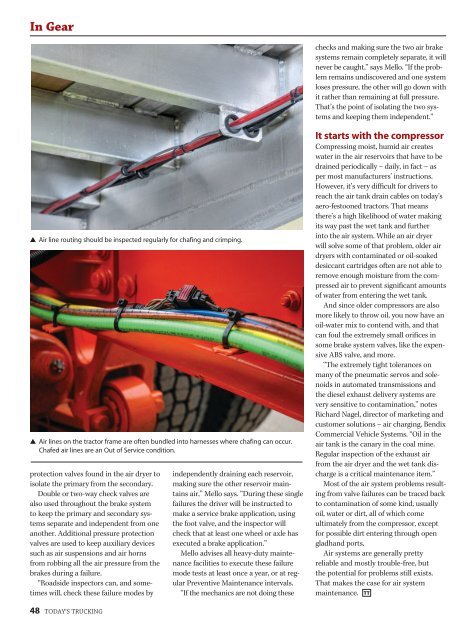DIGGING IN
2faRCNO
2faRCNO
You also want an ePaper? Increase the reach of your titles
YUMPU automatically turns print PDFs into web optimized ePapers that Google loves.
In Gear<br />
checks and making sure the two air brake<br />
systems remain completely separate, it will<br />
never be caught,” says Mello. “If the problem<br />
remains undiscovered and one system<br />
loses pressure, the other will go down with<br />
it rather than remaining at full pressure.<br />
That’s the point of isolating the two systems<br />
and keeping them independent.”<br />
Air line routing should be inspected regularly for chafing and crimping.<br />
Air lines on the tractor frame are often bundled into harnesses where chafing can occur.<br />
Chafed air lines are an Out of Service condition.<br />
protection valves found in the air dryer to<br />
isolate the primary from the secondary.<br />
Double or two-way check valves are<br />
also used throughout the brake system<br />
to keep the primary and secondary systems<br />
separate and independent from one<br />
another. Additional pressure protection<br />
valves are used to keep auxiliary devices<br />
such as air suspensions and air horns<br />
from robbing all the air pressure from the<br />
brakes during a failure.<br />
“Roadside inspectors can, and sometimes<br />
will, check these failure modes by<br />
independently draining each reservoir,<br />
making sure the other reservoir maintains<br />
air,” Mello says. “During these single<br />
failures the driver will be instructed to<br />
make a service brake application, using<br />
the foot valve, and the inspector will<br />
check that at least one wheel or axle has<br />
executed a brake application.”<br />
Mello advises all heavy-duty maintenance<br />
facilities to execute these failure<br />
mode tests at least once a year, or at regular<br />
Preventive Maintenance intervals.<br />
“If the mechanics are not doing these<br />
It starts with the compressor<br />
Compressing moist, humid air creates<br />
water in the air reservoirs that have to be<br />
drained periodically – daily, in fact – as<br />
per most manufacturers’ instructions.<br />
However, it’s very difficult for drivers to<br />
reach the air tank drain cables on today’s<br />
aero-festooned tractors. That means<br />
there’s a high likelihood of water making<br />
its way past the wet tank and further<br />
into the air system. While an air dryer<br />
will solve some of that problem, older air<br />
dryers with contaminated or oil-soaked<br />
desiccant cartridges often are not able to<br />
remove enough moisture from the compressed<br />
air to prevent significant amounts<br />
of water from entering the wet tank.<br />
And since older compressors are also<br />
more likely to throw oil, you now have an<br />
oil-water mix to contend with, and that<br />
can foul the extremely small orifices in<br />
some brake system valves, like the expensive<br />
ABS valve, and more.<br />
“The extremely tight tolerances on<br />
many of the pneumatic servos and solenoids<br />
in automated transmissions and<br />
the diesel exhaust delivery systems are<br />
very sensitive to contamination,” notes<br />
Richard Nagel, director of marketing and<br />
customer solutions – air charging, Bendix<br />
Commercial Vehicle Systems. “Oil in the<br />
air tank is the canary in the coal mine.<br />
Regular inspection of the exhaust air<br />
from the air dryer and the wet tank discharge<br />
is a critical maintenance item.”<br />
Most of the air system problems resulting<br />
from valve failures can be traced back<br />
to contamination of some kind, usually<br />
oil, water or dirt, all of which come<br />
ultimately from the compressor, except<br />
for possible dirt entering through open<br />
gladhand ports.<br />
Air systems are generally pretty<br />
reliable and mostly trouble-free, but<br />
the potential for problems still exists.<br />
That makes the case for air system<br />
maintenance. TT<br />
48 TODAY’S TRUCK<strong>IN</strong>G


